

The Allure of Grey Float Glass A Modern Construction Essential
In the ever-evolving world of architecture and design, materials play a pivotal role in shaping aesthetics and functionality. Among the diverse materials available, grey float glass has emerged as a popular choice, captivating architects, builders, and homeowners alike. This article delves into the characteristics, applications, and benefits of grey float glass, revealing why it is quickly becoming a staple in modern construction.
Understanding Grey Float Glass
Grey float glass, characterized by its subtle gray hue, is produced through the float glass process, a method that ensures uniform thickness and a smooth surface. The process involves melting raw materials, including silica sand, soda ash, and limestone, and then floating this molten glass on top of molten tin. This innovative technique not only results in a flat, distortion-free product but also allows for the incorporation of various tints and colors, including the alluring shade of grey.
Aesthetic Appeal
One of the primary reasons for the rising popularity of grey float glass is its aesthetic versatility. The neutral grey tone adds a contemporary edge to any architectural design, providing a sleek and sophisticated appearance. It can effortlessly complement various materials, including steel, wood, and concrete, making it an ideal choice for modern homes and commercial buildings. Whether used for windows, facades, or interior partitions, grey float glass enhances the overall visual appeal of a structure, creating a harmonious balance between light and shadow.
Natural Light and Privacy
Grey float glass is not just about looks; it also serves a functional purpose. One of its notable features is its ability to control the amount of natural light that enters a space. The grey tint helps reduce glare while still allowing ample light to filter through. This feature is particularly beneficial in urban environments where bright sunlight can be overwhelming. Furthermore, grey float glass provides a measure of privacy, enabling occupants to enjoy their spaces without sacrificing the benefits of natural light.

Energy Efficiency
In an age where energy efficiency is paramount, grey float glass stands out for its role in sustainable design. By reducing heat transfer, grey float glass can contribute to energy savings in both residential and commercial buildings. When used in double or triple glazing systems, it helps to create energy-efficient windows that keep indoor spaces comfortable year-round. The reduction in energy consumption not only minimizes utility bills but also aligns with environmental sustainability goals, making it an eco-friendly choice for modern architecture.
Versatility in Applications
The uses of grey float glass extend beyond mere windows. It has found applications in a variety of architectural elements, including curtain walls, skylights, balustrades, and interior partitions. Its design flexibility allows architects to experiment with different configurations and aesthetics, resulting in innovative and visually striking structures. Additionally, grey float glass can be processed further—tempered or laminated—enhancing its durability and safety for various applications.
Maintenance and Longevity
Another advantage of grey float glass is its low maintenance requirements. The smooth surface resists dirt and grime accumulation, making it easy to clean and maintain. With proper care, grey float glass can last for decades without significant degradation, making it a cost-effective investment for builders and homeowners alike.
Conclusion
In conclusion, grey float glass has established itself as a key material in modern construction, combining aesthetic appeal with practical benefits. Its versatile applications, energy efficiency, and low maintenance make it an attractive choice for architects and designers aiming to create innovative and sustainable structures. As the industry continues to embrace environmentally friendly practices, grey float glass stands at the forefront, embodying the perfect blend of style and substance. Whether enhancing a sleek urban office or providing a tranquil atmosphere in a home, grey float glass is undoubtedly a material worthy of consideration in the architectural landscape.